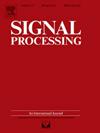事件触发的分布式m - δ- glmb滤波器
IF 3.4
2区 工程技术
Q2 ENGINEERING, ELECTRICAL & ELECTRONIC
引用次数: 0
摘要
边缘δ-广义标记多伯努利(Mδ-GLMB)滤波器在多目标跟踪中的有效性得到了验证,并提出了m - δ- glmb密度的融合规则,使其能够应用于分布式多目标跟踪。然而,Mδ-GLMB密度是基于假设形成的,这些假设的数量相对于标签集的基数呈指数增长,从而给传感器网络带来了沉重的通信负担。为了克服这一问题,本文设计了两种事件触发(ET)策略用于m - δ- glmb密度的融合,它们能够以轻微的性能损失为代价显著降低数据交换速率。具体而言,提出了一种调整ET策略假设权重的方法,以保证Mδ-GLMB密度的归一化。仿真结果验证了所提方法的有效性。本文章由计算机程序翻译,如有差异,请以英文原文为准。
An event-triggered distributed Mδ-GLMB filter
The marginalized -generalized labeled multi-Bernoulli (M-GLMB) filter has demonstrated its effectiveness in multi-target tracking, and fusion rules have been proposed for M-GLMB densities so as to allow its use in distributed multi-target tracking applications. However, the M-GLMB density is formed based on hypotheses whose numbers increase exponentially with respect to the cardinality of the label set, thus imposing a heavy communication burden on the sensor network. To overcome this problem, two event-triggered (ET) strategies are devised in this paper for fusion of M-GLMB densities, which are able to significantly reduce the data exchange rate at the price of a slight performance loss. Specifically, a method for tuning the hypothesis weights is proposed for the ET strategy so as to guarantee the normalization of the M-GLMB density. The effectiveness of the proposed methods is verified via simulation results.
求助全文
通过发布文献求助,成功后即可免费获取论文全文。
去求助
来源期刊

Signal Processing
工程技术-工程:电子与电气
CiteScore
9.20
自引率
9.10%
发文量
309
审稿时长
41 days
期刊介绍:
Signal Processing incorporates all aspects of the theory and practice of signal processing. It features original research work, tutorial and review articles, and accounts of practical developments. It is intended for a rapid dissemination of knowledge and experience to engineers and scientists working in the research, development or practical application of signal processing.
Subject areas covered by the journal include: Signal Theory; Stochastic Processes; Detection and Estimation; Spectral Analysis; Filtering; Signal Processing Systems; Software Developments; Image Processing; Pattern Recognition; Optical Signal Processing; Digital Signal Processing; Multi-dimensional Signal Processing; Communication Signal Processing; Biomedical Signal Processing; Geophysical and Astrophysical Signal Processing; Earth Resources Signal Processing; Acoustic and Vibration Signal Processing; Data Processing; Remote Sensing; Signal Processing Technology; Radar Signal Processing; Sonar Signal Processing; Industrial Applications; New Applications.
 求助内容:
求助内容: 应助结果提醒方式:
应助结果提醒方式:


